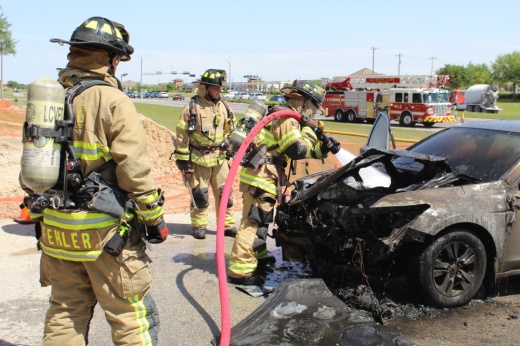Green, one of League City’s 140 volunteers, said his uncle, a former League City firefighter, inspired him to pursue firefighting.
“I think after the first structure I [put out], it pretty much locked it in that I wanted to be a career firefighter,” Green said.
As city estimates show the population surpassing 120,000, League City is closely monitoring recruitment numbers and looking to possibly add new fire stations.
In the meantime, League City is taking steps to fully utilize its current firefighters, including signing a contract with volunteers in December 2023.
The big picture
Established in 1939 with 33 volunteers, League City’s Fire Department initially served a rural community. However, as the city grew, the department had to adapt to fighting fires in an urbanizing environment.
With about 40% of League City still undeveloped, officials expect urbanization to continue.
“The responsibilities of course increase with that over time,” Fire Chief Michael Lugo said. “Response times is ... a very particular piece to it along with staffing of the [fire department].”
In December, League City Volunteer Fire Department Inc. signed a contract with the city mandating that two fire stations have fully staffed volunteer engines. However, the department has also created other avenues for backup support.
League City has agreements with nearby cities, such as Webster, for automatic aid in emergencies. This means firefighters can be dispatched from one city to another, ensuring the required personnel are always available. For example, a structure fire requires up to 16 firefighters to be present at once.
For League City’s current size, Daniel Gibbs, who has been a League City firefighter for 21 years, said having 180 volunteers would be ideal. Considering that there are 140 volunteers—with an annual attrition rate of five firefighters—recruitment is a priority, Gibbs said.
“Fire doesn’t know the difference between a paid individual and a volunteer,” Gibbs said. “So you have to be just as well-trained, informed and educated as you are as a professional volunteer. So we don’t cut corners ... just to make numbers.”
According to League City, some numbers to illustrate the work done by firefighters include:
- 9 minutes was the average response time in 2021
- 1,864 calls were received by the department in 2023
- 120 hours of training through the College of the Mainland are required to become a volunteer firefighter
- 8,000 hours of collective training are required annually by volunteer firefighters
- 5 cadets on average graduate each year
- $16 million-$18 million of taxpayers' money is saved annually by having volunteers instead of full-time employees
About the program
Despite being an all-volunteer department, League City in 2016 received an Insurance Services Office score of 1—the scale’s highest possible score—placing the city in the 99.5% percentile nationwide for both on-staff and volunteer fire departments, according to League City’s website.
An ISO assesses fire departments on their adherence to safety and operational standards to determine property insurance costs, according to the Texas Department of Insurance.
“We’re one of the only volunteer fire departments that has that top ranking as well,” Mayor Nick Long said at League City’s Feb. 29 State of the City address.
ISO grades more than 50,000 fire departments nationwide, but only 75 Texas departments and 411 nationwide departments have earned a Class 1 rating, according to Community Volunteer Fire Department’s website.
To capture an ISO score, cities are rated on factors within three major categories—communications, water and the fire department, according to the Texas Department of Insurance. The following items within those categories are measured:
- Dispatch and the department’s 911 system
- Water supply
- Number of fire stations
- Training hours
- Response times and the number of firefighters a department can get on the scene of a structure fire within nine minutes
The condition
The contract signed between the League City Volunteer Fire Department Inc. and the city mandated that two of the city’s six fire stations have fully staffed engines with volunteers.
One is located at Fire Station 2, and the other at Fire Station 6, with a minimum of three firefighters staffed during the daytime, Lugo said.
In the event of a structure fire, those two engines will respond first, and available volunteers will be notified and report to the nearest of the city’s six fire stations to support if they can, Lugo said. This allows for quicker responses to fires.
“To get from the far east side to deep west if there’s a house fire, ... that’s a long time depending on the route you have to go,” Lugo said.
As League City moves toward developing its unused land, the city is looking closely at increasing its number of fire stations to fill in the gaps and service in newly developed areas, city officials said.
In their own words
“A lot of people don’t even realize that ... we’re a volunteer department, and kind of the correlation with that is how much money the city saves in taxes by not having to pay us full-time salaries and benefits,” said Kevin Mattler, five-year League City volunteer firefighter.
“Because League City itself is so diverse, ... we have everything from blue-collar workers that are volunteers to literally NASA scientists, rocket scientists, business owners and project managers," said Daniel Gibbs, 21-year League City firefighter.
Looking ahead
As League City continues to grow, the city is considering adding at least two more fire stations, which could cost between $10.6 million and $12 million to build, according to the fire department. “Once we pick a site, it’s ... [three] years to design and construct and to get a station up,” City Manager John Baumgartner said.





